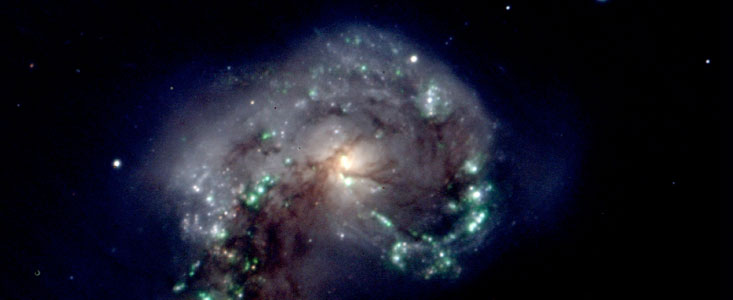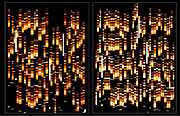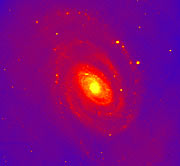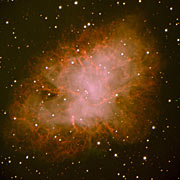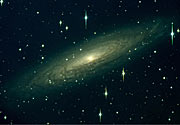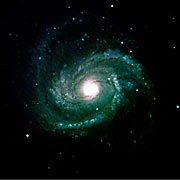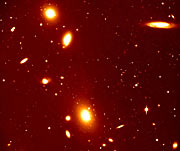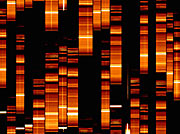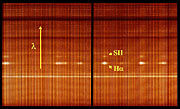Press Release
VIMOS - a Cosmology Machine for the VLT
Successful Test Observations With Powerful New Instrument at Paranal
13 March 2002
One of the most fundamental tasks of modern astrophysics is the study of the evolution of the Universe . This is a daunting undertaking that requires extensive observations of large samples of objects in order to produce reasonably detailed maps of the distribution of galaxies in the Universe and to perform statistical analysis. Much effort is now being put into mapping the relatively nearby space and thereby to learn how the Universe looks today . But to study its evolution, we must compare this with how it looked when it still was young . This is possible, because astronomers can "look back in time" by studying remote objects - the larger their distance, the longer the light we now observe has been underway to us, and the longer is thus the corresponding "look-back time." This may sound easy, but it is not. Very distant objects are very dim and can only be observed with large telescopes. Looking at one object at a time would make such a study extremely time-consuming and, in practical terms, impossible. To do it anyhow, we need the largest possible telescope with a highly specialised, exceedingly sensitive instrument that is able to observe a very large number of (faint) objects in the remote universe simultaneously. The VLT VIsible Multi-Object Spectrograph (VIMOS) is such an instrument. It can obtain many hundreds of spectra of individual galaxies in the shortest possible time; in fact, in one special observing mode, up to 6400 spectra of the galaxies in a remote cluster during a single exposure, augmenting the data gathering power of the telescope by the same proportion. This marvellous science machine has just been installed at the 8.2-m MELIPAL telescope, the third unit of the Very Large Telescope (VLT) at the ESO Paranal Observatory. A main task will be to carry out 3-dimensional mapping of the distant Universe from which we can learn its large-scale structure. "First light" was achieved on February 26, 2002, and a first series of test observations has successfully demonstrated the huge potential of this amazing facility. Much work on VIMOS is still ahead during the coming months in order to put into full operation and fine-tune the most efficient "galaxy cruncher" in the world. VIMOS is the outcome of a fruitful collaboration between ESO and several research institutes in France and Italy, under the responsibility of the Laboratoire d'Astrophysique de Marseille (CNRS, France). The other partners in the "VIRMOS Consortium" are the Laboratoire d'Astrophysique de Toulouse, Observatoire Midi-Pyrénées, and Observatoire de Haute-Provence in France, and Istituto di Radioastronomia (Bologna), Istituto di Fisica Cosmica e Tecnologie Relative (Milano), Osservatorio Astronomico di Bologna, Osservatorio Astronomico di Brera (Milano) and Osservatorio Astronomico di Capodimonte (Naples) in Italy.
Science with VIMOS
The next in the long series of front-line instruments to be installed on the ESO Very Large Telescope (VLT), VIMOS (and its complementary, infrared-sensitive counterpart NIRMOS, now in the design stage) will allow mapping of the distribution of galaxies, clusters, and quasars during a time interval spanning more than 90% of the age of the universe. It will let us look back in time to a moment only ~1.5 billion years after the Big Bang (corresponding to a redshift of about 5).
Like archaeologists, astronomers can then dig deep into those early ages when the first building blocks of galaxies were still in the process of formation. They will be able to determine when most of the star formation occurred in the universe and how it evolved with time. They will analyse how the galaxies cluster in space, and how this distribution varies with time. Such observations will put important constraints on evolution models, in particular on the average density of matter in the Universe.
Mapping the distant universe requires to determine the distances of the enormous numbers of remote galaxies seen in deep pictures of the sky, adding depth - the third, indispensible dimension - to the photo. VIMOS offers this capability, and very efficiently. Multi-object spectroscopy is a technique by which many objects are observed simultaneously. VIMOS can observe the spectra of about 1000 galaxies in one exposure, from which redshifts, hence distances, can be measured [2]. The possibility to observe two galaxies at once would be equivalent to having a telescope twice the size of a VLT Unit Telescope. VIMOS thus effectively "increases" the size of the VLT hundreds of times.
From these spectra, the stellar and gaseous content and internal velocities of galaxies can be infered, forming the base for detailed physical studies. At present the distances of only a few thousand galaxies and quasars have been measured in the distant universe. VIMOS aims at observing 100 times more, over one hundred thousand of those remote objects. This will form a solid base for unprecedented and detailed statistical studies of the population of galaxies and quasars in the very early universe.
The international VIRMOS Consortium
VIMOS is one of two major astronomical instruments to be delivered by the VIRMOS Consortium of French and Italian institutes under a contract signed in the summer of 1997 between the European Southern Observatory (ESO) and the French Centre National de la Recherche Scientifique (CNRS). The participating institutes are:
in France:
- Laboratoire d'Astrophysique de Marseille (LAM), Observatoire Marseille-Provence (project responsible)
- Laboratoire d'Astrophysique de Toulouse, Observatoire Midi-Pyrénées
- Observatoire de Haute-Provence (OHP)
in Italy:
- Istituto di Radioastronomia (IRA-CNR) (Bologna)
- Istituto di Fisica Cosmica e Tecnologie Relative (IFCTR) (Milano)
- Osservatorio Astronomico di Capodimonte (OAC) (Naples)
- Osservatorio Astronomico di Bologna (OABo)
- Osservatorio Astronomico di Brera (OABr) (Milano)
VIMOS at the VLT: a unique and powerful combination
VIMOS is installed on the Nasmyth "Focus B" platform of the 8.2-m VLT MELIPAL telescope, cf. ESO Press Photo eso0209 . It may be compared to four multi-mode instruments of the FORS-type, joined in one stiff structure. The construction of VIMOS has involved the production of large and complex optical elements and their integration in more than 30 remotely controlled, finely moving functions in the instrument.
In the configuration employed for the "first light", VIMOS made use of two of its four channels. The two others will be put into operation in the next commissioning period during the coming months. However, VIMOS is already now the most efficient multi-object spectrograph in the world, with an equivalent (accumulated) slit length of up to 70 arcmin on the sky.
VIMOS has a field-of-view as large as half of the full moon (14 x 16 arcmin 2 for the four quadrants), the largest sky field to be imaged so far by the VLT. It has excellent sensitivity in the blue region of the spectrum (about 60% more efficient than any other similar instruments in the ultraviolet band), and it is also very sensitive in all other visible spectral regions, all the way to the red limit.
But the absolutely unique feature of VIMOS is its capability to take large numbers of spectra simultaneously, leading to exceedingly efficient use of the observing time. Up to about 1000 objects can be observed in a single exposure in multi-slit mode. And no less than 6400 spectra can be recorded with the Integral Field Unit, in which a closely packed fibre optics bundle can simultaneously observe a continuous sky area measuring no less than 56 x 56 arcsec 2.
A dedicated machine, the Mask Manufacturing Unit (MMU), cuts the slits for the entrance apertures of the spectrograph. The laser is capable of cutting 200 slits in less than 15 minutes. This facility was put into operation at Paranal by the VIRMOS Consortium already in August 2000 and has since been extensively used for observations with the FORS2 instrument; more details are available in eso9919.
Fast start-up of VIMOS at Paranal
VIMOS was shipped from Observatoire de Haute-Provence (France) at the end of 2001, and reassembled at Paranal during a first period in January 2002. From mid-February, the instrument was made ready for installation on the VLT MELIPAL telescope; this happened on February 24, 2002. VIMOS saw "First Light" just two days later, on February 26, 2000, cf. ESO Press Photo eso0209 . During the same night, a number of excellent images were obtained of various objects, demonstrating the fine capabilities of the instrument in the "direct imaging"-mode.
The first spectra were successfully taken during the night of March 2 - 3, 2002 . The slit masks that were used on this occasion were prepared with dedicated software that also optimizes the object selection, cf. ESO Press Photo eso0209, and were then cut with the laser machine. From the first try on, the masks have been well aligned on the sky objects. The first observations with large numbers of spectra were obtained shortly thereafter.
First accomplishments
Images of nearby galaxies, clusters of galaxies, and distant galaxy fields were among the first to be obtained, using the VIMOS imaging mode and demonstrating the excellent efficiency of the instrument, various examples are shown below.
The first observations of multi-spectra were performed in a selected sky field in which many faint galaxies are present; it is known as the "VIRMOS-VLT Deep Survey Field at 1000+02".
Thanks to the excellent sensitivity of VIMOS, the spectra of galaxies as faint as (red) magnitude R = 23 (i.e. over 6 million times fainter than what can be perceived with the unaided eye) are visible on exposures lasting only 15 minutes.
Some of the first observations with the Integral Field Unit were made of the core of the famous Antennae Galaxies (NGC 4038/39) . They will form the basis for a detailed map of the strong emission produced by the current, dramatic collision of the two galaxies.
Notes
[1] This is a joint Press Release of ESO, Centre National de la Recherche Scientifique (CNRS) in France, and Consiglio Nazionale delle Ricerche (CNR) and Istituto Nazionale di Astrofisica (INAF) in Italy.
[2] In astronomy, the redshift denotes the fraction by which the lines in the spectrum of an object are shifted towards longer wavelengths. The observed redshift of a distant galaxy gives a direct estimate of the apparent recession velocity as caused by the universal expansion. Since the expansion rate increases with distance, the velocity is itself a function (the Hubble relation) of the distance to the object.
More information
Technical information about the photos
ESO Press Photo eso0209a : Composite VRI image of NGC 4038/39, obtained on 26 February 2002, in a bright sky (full moon). Individual exposures of 60 sec each; image quality 0.6 arcsec FWHM; the field measures 3.5 x 3.5 arcmin 2. North is up and East is left. ESO Press Photo eso0209b : MOS-spectra obtained with two quadrants totalling 221 slits + 6 reference objects (stars placed in square holes to ensure a correct alignment). Exposure time 15 min; LR(red) grism. This is the raw (unprocessed) image of the spectra. ESO Press Photo eso0209e : A 60 sec i exposure of NGC 5364 on February 26, 2002; image quality 0.6 arcsec FWHM; full moon; 3.5 x 3.5 arcmin 2 ; North is up and East is left. ESO Press Photo eso0209f : Composite VRI image of Messier 1, obtained on March 4, 2002. The individual exposures lasted 180 sec; image quality 0.7 arcsec FWHM; field 7 x 7 arcmin 2 ; North is up and East is left. ESO Press Photo eso0209g : Composite VRI image of NGC 2613, obtained on February 28, 2002. The individual exposures lasted 180 sec; image quality 0.7 arcsec FWHM; field 7 x 7 arcmin 2 ; North is up and East is left. ESO Press Photo eso0209h : Composite VRI image of Messier 100, obtained on March 3, 2002. The individual exposures lasted 180 sec, image quality 0.7 arcsec FWHM; field 7 x 7 arcmin 2 ; North is up and East is left. ESO Press Photo eso0209i : R-band image of galaxy cluster ACO 3341, obtained on March 4, 2002. Exposure 300 sec, image quality 0.5 arcsec FWHM;. field 7 x 7 arcmin 2 ; North is up and East is left. ESO Press Photo eso0209j : Composite VRI image of the distant cluster of galaxies MS 1008.1-1224. The individual exposures lasted 300 sec; image quality 0.8 arcsec FWHM; field 5 x 3 arcmin 2 ; North is to the right and East is up. ESO Press Photo eso0209k : Mask design made with the VMMPS tool, overlaying a pre-image. The selected objects are seen at the centre of the yellow squares, where a 1 arcsec slit is cut along the spatial X-axis. The rectangles in white represent the dispersion in wavelength of the spectra along the Y-axis. Masks are cut with the Mask Manufacturing Unit (MMU) built by the Virmos Consortium. ESO Press Photo eso0209l : Enlargement of a small area of ESO Press Photo eso0209b. ESO Press Photo eso0209m : Spectra of the central area of NGC 4038/39, obtained with the Integral Field Unit on February 26, 2002. The exposure lasted 5 min and was made with the low resolution red grating. ESO Press Photo eso0209n : Zoom-in on small area of ESO Press Photo eso0209b. The strong emission lines of hydrogen (H-alpha) and ionized sulphur (S II) are seen.
Contacts
Olivier Le Fevre
Laboratoire d'Astrophysique de Marseille
Marseille, France
Tel: +33 6 08 90 50 43
Email: Olivier.LeFevre@astrsp-mrs.fr
Gianpaolo Vettolani
Istituto di Radioastronomia
Bologna, France
Tel: +39 051 6399369
Email: vettolani@ira.cnr.it
Sandro d'Odorico
ESO
Garching, Germany
Tel: +4989-3200-6239
Email: sdodoric@eso.org
About the Release
| Release No.: | eso0209 |
| Legacy ID: | PR 04/02 |
| Name: | ACO 3341, Antennae Galaxies, Crab Nebula, Instrumentation, M 100, Messier 100, MS 1008.1-1224, NGC 2613, NGC 4038, NGC 4039, NGC 5364, Spectrum |
| Type: | Local Universe : Galaxy : Type : Interacting |
| Facility: | Very Large Telescope |
| Instruments: | VIMOS |
Our use of Cookies
We use cookies that are essential for accessing our websites and using our services. We also use cookies to analyse, measure and improve our websites’ performance, to enable content sharing via social media and to display media content hosted on third-party platforms.
ESO Cookies Policy
The European Organisation for Astronomical Research in the Southern Hemisphere (ESO) is the pre-eminent intergovernmental science and technology organisation in astronomy. It carries out an ambitious programme focused on the design, construction and operation of powerful ground-based observing facilities for astronomy.
This Cookies Policy is intended to provide clarity by outlining the cookies used on the ESO public websites, their functions, the options you have for controlling them, and the ways you can contact us for additional details.
What are cookies?
Cookies are small pieces of data stored on your device by websites you visit. They serve various purposes, such as remembering login credentials and preferences and enhance your browsing experience.
Categories of cookies we use
Essential cookies (always active): These cookies are strictly necessary for the proper functioning of our website. Without these cookies, the website cannot operate correctly, and certain services, such as logging in or accessing secure areas, may not be available; because they are essential for the website’s operation, they cannot be disabled.
Functional Cookies: These cookies enhance your browsing experience by enabling additional features and personalization, such as remembering your preferences and settings. While not strictly necessary for the website to function, they improve usability and convenience; these cookies are only placed if you provide your consent.
Analytics cookies: These cookies collect information about how visitors interact with our website, such as which pages are visited most often and how users navigate the site. This data helps us improve website performance, optimize content, and enhance the user experience; these cookies are only placed if you provide your consent. We use the following analytics cookies.
Matomo Cookies:
This website uses Matomo (formerly Piwik), an open source software which enables the statistical analysis of website visits. Matomo uses cookies (text files) which are saved on your computer and which allow us to analyze how you use our website. The website user information generated by the cookies will only be saved on the servers of our IT Department. We use this information to analyze www.eso.org visits and to prepare reports on website activities. These data will not be disclosed to third parties.
On behalf of ESO, Matomo will use this information for the purpose of evaluating your use of the website, compiling reports on website activity and providing other services relating to website activity and internet usage.
Matomo cookies settings:
Additional Third-party cookies on ESO websites: some of our pages display content from external providers, e.g. YouTube.
Such third-party services are outside of ESO control and may, at any time, change their terms of service, use of cookies, etc.
YouTube: Some videos on the ESO website are embedded from ESO’s official YouTube channel. We have enabled YouTube’s privacy-enhanced mode, meaning that no cookies are set unless the user actively clicks on the video to play it. Additionally, in this mode, YouTube does not store any personally identifiable cookie data for embedded video playbacks. For more details, please refer to YouTube’s embedding videos information page.
Cookies can also be classified based on the following elements.
Regarding the domain, there are:
- First-party cookies, set by the website you are currently visiting. They are stored by the same domain that you are browsing and are used to enhance your experience on that site;
- Third-party cookies, set by a domain other than the one you are currently visiting.
As for their duration, cookies can be:
- Browser-session cookies, which are deleted when the user closes the browser;
- Stored cookies, which stay on the user's device for a predetermined period of time.
How to manage cookies
Cookie settings: You can modify your cookie choices for the ESO webpages at any time by clicking on the link Cookie settings at the bottom of any page.
In your browser: If you wish to delete cookies or instruct your browser to delete or block cookies by default, please visit the help pages of your browser:
Please be aware that if you delete or decline cookies, certain functionalities of our website may be not be available and your browsing experience may be affected.
You can set most browsers to prevent any cookies being placed on your device, but you may then have to manually adjust some preferences every time you visit a site/page. And some services and functionalities may not work properly at all (e.g. profile logging-in, shop check out).
Updates to the ESO Cookies Policy
The ESO Cookies Policy may be subject to future updates, which will be made available on this page.
Additional information
For any queries related to cookies, please contact: pdprATesoDOTorg.
As ESO public webpages are managed by our Department of Communication, your questions will be dealt with the support of the said Department.
